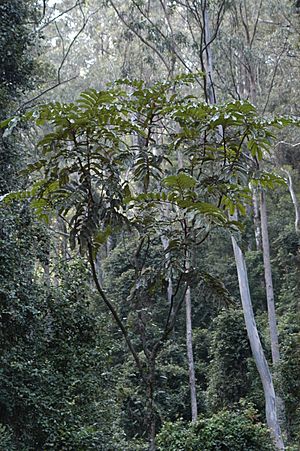Native tamarind facts for kids
Diploglottis australis, also known as the native tamarind, is a cool rainforest tree found in eastern Australia. You can easily spot it by its big, sausage-shaped leaves. It's a well-known tree that adds a lot to the Australian rainforests.
The native tamarind grows in many different types of rainforests. It likes rich soils, often found near basalt rocks or rivers. You can find it naturally along the east coast of Australia. Its most southern point is near Bega in New South Wales. It grows all the way north to Proserpine in tropical Queensland.
Quick facts for kids Native tamarind |
|
|---|---|
 |
|
| Native tamarind in a rainforest gully of Mount Royal National Park, Barrington Tops, Australia | |
| Scientific classification | |
| Genus: |
Diploglottis
|
| Species: |
australis
|
| Synonyms | |
Contents
What Does It Look Like?
This tree can grow quite large. It often reaches over 35 metres tall. Its trunk can be as wide as 75 centimetres across. The trunk is usually straight and round, with a slightly wider base. It looks a bit like the trunk of a Coachwood tree.
The branches have large leaves that grow in an alternating pattern. These leaves are long and wide, usually 40 to 120 centimetres in length. Each mature leaf has about 6 to 12 smaller leaflets. Young plants or new shoots might have leaves with only 3 to 5 leaflets.
The leaflets are commonly 10 to 30 centimetres long and 4 to 8 centimetres wide. They are broadly oval-shaped with a blunt tip. The base of each leaflet is often uneven. They might also have soft, golden-brown hairs. You can easily see the leaf veins on both sides, especially on the underside. The main vein is slightly raised on the top surface.
Flowers and Fruit
The native tamarind produces flowers in spring. These flowers are creamy brown and grow in large, hairy clusters called panicles. A panicle is a branched cluster of flowers.
The fruit is a brown, hairy capsule. It ripens between October and January. Inside the capsule is a yellow or orange part called an aril. This aril is tasty and can be eaten. Hidden inside the aril is a triangular, pale brown seed.
Life Cycle and Spreading Seeds
The seeds of the native tamarind usually sprout quickly and easily. However, seeds found on the damp ground often have small insect grubs inside them.
Many different rainforest birds love to eat the fruit, especially the aril. When they eat the fruit, they help spread the seeds to new places. Some of these birds include the Brown cuckoo-dove, crimson rosella, Australasian figbird, green catbird, regent bowerbird, Australian brush-turkey, rose-crowned fruit-dove, topknot pigeon, and wompoo fruit-dove.
How People Use It
The native tamarind is sometimes planted as a beautiful tree in Australian cities. You can even see one behind the Mitchell Library in Sydney. However, its large leaves can get damaged easily by strong winds, so it's not always the best choice for windy spots.
This tree is also valued for its fruit. The aril can be eaten fresh as a snack. People also use it to make jams and chutneys. It can even be used to create a tangy, cool drink.
Images for kids
See also
 In Spanish: Tamarindo Australiano para niños
In Spanish: Tamarindo Australiano para niños





